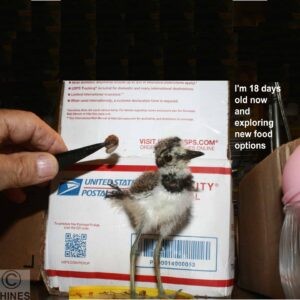Killdeer are captivating birds, known for their distinctive broken-wing act to distract predators from their nests and chicks. With their striking plumage and ground-dwelling habits, it’s understandable why some might wonder, “Can You Keep A Killdeer As A Pet?”. As experts at pets.edu.vn, we delve into the realities of keeping killdeer and other wild birds, focusing on their welfare and the legal and ethical considerations involved.
While the idea of caring for a killdeer might stem from a place of compassion, particularly if you’ve found a seemingly abandoned chick, it’s crucial to understand that killdeer are wild animals, not domesticated pets. Their needs and natural behaviors are intricately linked to their wild existence, making them unsuitable for home environments.
The Legalities of Keeping Killdeer: Understanding Wildlife Protection Laws
Before even considering keeping a killdeer, it’s vital to address the legal aspects. In most countries, including the United States under the Migratory Bird Treaty Act, it is illegal to possess migratory birds like killdeer without proper permits. These laws are in place to protect wild bird populations and ecosystems. Keeping a killdeer without authorization can result in hefty fines and legal repercussions.
Furthermore, even with permits, these are generally granted to licensed wildlife rehabilitators whose goal is to care for injured or orphaned birds and release them back into their natural habitat. Permits are not issued for keeping wild birds as personal pets. Therefore, from a legal standpoint, keeping a killdeer as a pet is generally prohibited.
Killdeer Natural Behaviors and Needs: Why They Aren’t Suited for Captivity
Beyond legalities, the very nature of killdeer makes them unsuitable pets. These birds are precocial, meaning their chicks are relatively independent from birth, able to feed themselves shortly after hatching. This independence is crucial for their survival in the wild, where they forage for insects and navigate open terrains.
Confining a killdeer to a cage or domestic environment deprives them of their natural behaviors and essential freedoms. They require ample space to roam, forage, and exhibit their natural ground-dwelling and flying behaviors. Their diet consists primarily of insects and invertebrates found in varied natural environments, which can be challenging and potentially inadequate to replicate in a home setting.

A killdeer chick standing on grass, showcasing its natural habitat and alert posture.
Killdeer are also highly sensitive to stress. Captivity can induce significant stress, leading to weakened immune systems and various health issues. Their wild instincts and need for freedom are deeply ingrained, and attempting to domesticate them is not only unethical but also detrimental to their well-being.
Caring for a Found Killdeer Chick: Rehabilitation, Not Pet Ownership
The scenario where you might encounter a killdeer chick often involves finding one that appears to be alone and vulnerable. While your first instinct might be to “rescue” it and consider keeping it, the most responsible and ethical approach is to consider wildlife rehabilitation.
If you find a killdeer chick that seems injured, orphaned, or in immediate danger, the best course of action is to contact your local wildlife rehabilitation center or animal control. These professionals have the expertise, facilities, and legal permits to properly care for wild birds with the goal of releasing them back into the wild.
In some cases, if you are unable to immediately reach a rehabilitation center, you may need to provide temporary care. The following information is adapted from experienced wildlife rehabilitators and focuses on short-term care for eventual release, not long-term pet ownership.
Initial Care for Fragile Killdeer Chicks: Hydration and Warmth
Newly hatched or weak killdeer chicks often arrive dehydrated and fragile. Similar to the practices of experienced rehabilitators, initial care should focus on hydration. A veterinarian or licensed rehabilitator might recommend a subcutaneous solution of 5% dextrose/0.45% saline solution to combat dehydration, especially if the chick has been exposed to the sun.
Warmth is also crucial. A brooder or a warm, quiet space can help the chick stabilize. Avoid handling the chick excessively to minimize stress.
A killdeer chick in a controlled incubator environment, highlighting the need for specialized care in early stages.
Diet and Feeding: Replicating a Natural Insectivorous Diet
Once the chick is stable, feeding is the next priority. For very young or weak killdeer, a temporary diet of beaten raw egg can be easily digestible and administered, even through a catheter for very small foundlings, as practiced by experienced rehabilitators.
As the chick grows stronger, their diet should transition to insects. A mix of small insects like wood cockroaches, earwigs, and flies can mimic their natural food sources. Collecting these insects can be done using methods like carpet traps in damp areas or fly traps. Mealworms can also be offered as a supplement, ensuring they are sourced from reputable suppliers to minimize parasite risks.
A collection of insects, representing the natural diet of killdeer, essential for their health and development.
It’s important to offer a variety of insects to ensure a balanced diet. Supplementing with moistened cat chow can provide protein, but insects should remain the primary food source. Always provide fresh, clean water with smooth stones in the dish to prevent chicks from getting wet and chilled.
Housing and Environment: Simulating Natural Conditions
While in care, the housing for a killdeer chick should prioritize safety and mimic their natural environment as much as possible. A spacious enclosure with a substrate like grass or leaf litter is preferable to allow for natural foraging behaviors.
Providing shallow dishes of water and food, along with hiding places, can reduce stress. Avoid keeping the chick in a completely sterile environment, as exposure to natural elements and varied textures can be beneficial for their development and eventual release.
Release and Ethical Considerations: Returning to the Wild
The ultimate goal of caring for a found killdeer should always be release back into the wild. Killdeer are wild creatures, and their well-being is intrinsically linked to their natural habitat and freedom.
Suitable release locations should be safe from predators like domestic cats and dogs, away from heavy traffic, and offer access to appropriate foraging grounds. Parks, cemeteries, or undeveloped areas with open spaces can be considered, but it’s crucial to assess the specific location for potential hazards.
Releasing a hand-raised killdeer is a critical step that requires careful consideration to ensure their successful integration back into the wild. Avoid imprinting the bird on humans by minimizing human interaction and, if possible, using visual barriers like mirror boxes during care.
A mirror box setup, used in wildlife rehabilitation to minimize human imprinting on young birds.
Conclusion: Respecting Killdeer as Wild Animals
In conclusion, while the allure of keeping a killdeer as a pet might be understandable, it is neither legal nor ethical. Killdeer are wild birds that belong in their natural habitat. Their complex needs, legal protection, and inherent wildness make them entirely unsuitable for domestication.
If you encounter a killdeer in need, remember that the most compassionate action is to seek professional wildlife rehabilitation. By supporting wildlife centers and respecting wildlife laws, we contribute to the conservation and well-being of these fascinating birds in their natural world. Let us appreciate killdeer for their wild beauty and ensure their continued presence in our ecosystems, rather than attempting to confine them as pets.
